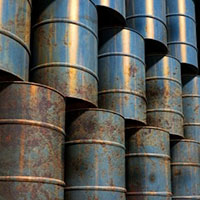Sour service corrosion basics, or how bad can one bad apple be…

If you buy 20 barrels of apples and you only got one bad apple, well it can’t be that bad? May be it’s ok for apples, but that same proportion can be deadly when it comes to H2S; I know this might not be the best use of mathematical analogy but close enough to get someone’s attention.
In a previous blog I discussed the difference between sour crude and sweet crude, the main difference being the sulphur content. The sulphur in oil and gas production environments is most commonly present in the form of hydrogen sulphide (H2S), in today’s post I want to review the main risks of H2S in production environments.
First I need to stress H2S kills! Even at very low concentrations H2S is deadly. Government regulators, health and safety bodies and industry associations across the world stressed this out. Exposure to concentrations as low as 100ppm of H2S can have deadly consequences. I have borrowed the image shown below from another source to portrait the risk of H2S exposure. This is the highest risk when dealing with sour service corrosion.
Not only H2S is a threat to life, it can also lead to corrosion in many forms. ISO 15156 / NACE MR0175 Petroleum and natural gas industries — Materials for use in H2S-containing environments in oil and gas production is the main standard for materials selection in H2S environments. This standard in section 2 indicates when the partial pressure of H₂S is above 0.05psi (0.0034bar) we must take special considerations to minimise the risk of failures due to corrosion associated to H2S. So, a concentration of 100ppm of H₂S is not only deadly but may also lead to severe corrosion problems!
Those deadly 100ppm of H2S when the operating pressure is above 34 bar (500psi) becomes 0.05psi of H2S partial pressure and may lead to sour corrosion problems. Corrosion due to H2S can manifest in the following forms:
Pitting attack from the deposition of solid sulphides: Iron Sulphides are the main product of H2S reacting with the iron in the steel, the evolution of iron sulphides is complex and all I will say at this stage is that a sulphide created upstream at the tubing may continue to cause corrosion downstream at the pipeline and even topsides.
Pitting attack at areas of breakdown of sulphide films formed on the pipeline surface: H2S reacts with the steel metal surface and creates a film, this film can act as a protective layer against sweet corrosion (corrosion by CO2), but if the film breaks localised pitting corrosion will occur.
Sulphide Stress Cracking (SSC): SSC is the result of a combination of stress and H2S. The stress may be induced by operating pressure, loads or it may be a residual stress. H2S acts as a source of hydrogen, in sour environments this hydrogen will diffuse into the steel and creates high stress concentration points that lead to brittle fracture. Using steel with low hardness (22HRC) is one of the main methods to minimise the risk of SSC.
Hydrogen Induced cracking (HIC) and blistering: as mentioned before, H2S acts as a hydrogen source, and H2S increases the uptake of hydrogen into steel, when enough hydrogen diffuses into the steel blistering may occur and lead to cracking regardless of the level of stress. Plate steels are the most susceptible to this type of cracking. When the HIC phenomenon is coupled with stress, Stress Oriented Induced-cracking (SOHIC) may occur.
So, what do we do to avoid these risks? The answer is Materials Selection. Corrosion by H2S can be managed and the risks of failures mitigated with adequate materials selection. Carbon Steel can be used in the presence of H2S, and when the risk of failure is too high for Carbon Steel the use of Corrosion Resistant Alloys is required. Materials selection depends on many factors, H2S content is important, but also CO2, pH, pressure and temperature etc. Our job as corrosion specialists and metallurgists is to select the correct material and ensure that the manufacture complies with the requirements that will minimise the risk of failure due to H2S.
Contact us to discuss H2S Management, use our webchat for materials and corrosion support.
Sour service corrosion, Apples and parts per million….
One bushel contains around 126 medium apples, and 3.75 bushels make a barrel. Therefore one apple in 20 barrels 1/9,450, which equals to 100/1000000 or 100ppm…
If you want to read more:
Kane, R.D. . Roles of H₂S in Behavior of Engineering Alloys. International Metals Review, 30, 291–301 (1985)
Heidersbach R, Metallurgy and corrosion control in oil and gas production, Wiley, 2011.
And if you want to learn more about sour service corrosion …
P.R. Rhodes, Environment-Assisted Cracking of Corrosion-Resistant Alloys in Oil and Gas Production Environments: A Review, CORROSION–Vol. 57, No. 11 (2001)
P.R. Rhodes, L.A. Skogsberg, and R.N. Tuttle. Pushing the Limits of Metals in Corrosive Oil and Gas Well Environments, CORROSION—Vol. 63, No. 1 (2007)



